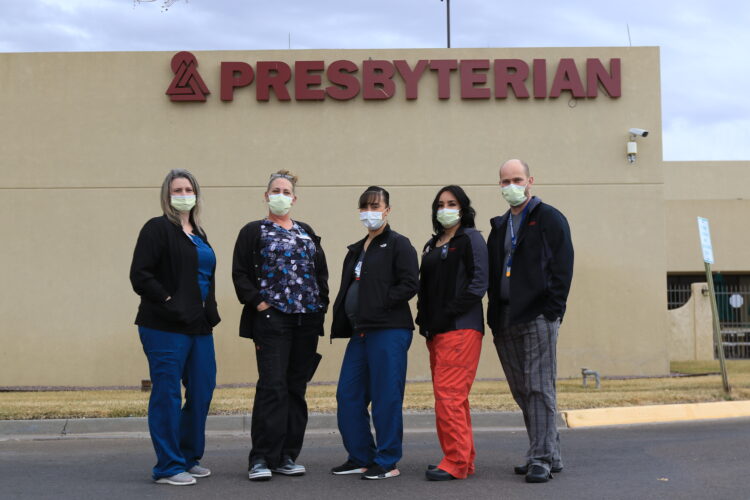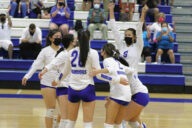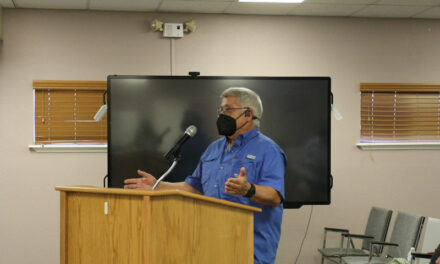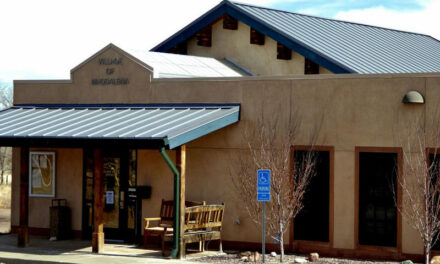
From left, Stephanie O’Toole, Samantha Rainsdon, Bryahna Baca, Alisha Benavidez and Adrian Morris are five of the staff at Socorro General Hospital who have been working the front lines during the COVID-19 pandemic.
Caitie Ihrig | El Defensor Chieftain
Everyday when Alisha Benavidez got home from work, her kids wanted to run over and give her a hug.
Benavidez, who is a nurse and a clinical supervisor for the Socorro General Medical Group outpatient clinic, was constantly worried about bringing COVID-19 home to her husband and kids.
“As soon as I get home, the kids want to be over and hugging me and I had to tell them no and to give me some time to do what I had to do before I could interact with them to try and keep them safe,” she said. “Because of my job, they were more at risk. It was a constant, everyday struggle. It was hard.”
Before Benavidez left the clinic each day, she would change her clothes and shoes. Her scrubs went straight into the washer at her house and her shoes were left outside.
To protect her family even more, she and her husband did not allow any visitors to their house.
“That was hard,” she said. “We had to stay away from a lot of family. We didn’t really interact with a lot of people because of my current job in the medical field. I did not feel comfortable doing that so we did not have visitors.”
Stephanie O’Toole, who is a nurse in the emergency department and in the medical surgical unit at Socorro General Hospital, had a similar routine to Benavidez.
O’Toole would have her “husband hold the kids back” while she put her clothes from the day in the laundry, took a shower and used a UV cleaner for anything that needed to be sanitized.
While O’Toole is on shift at SGH she is wearing full PPE gear, which includes a surgical cap, a fabric cap, a face mask, a protective gown and more.
O’Toole said that when the COVID-19 pandemic first started, all of the nurses and SGH staff were very nervous because the guidelines and requirements were constantly changing. They were also worried that PPE would run out.
“We had so many forms of help and support from the community,” she said. “The Fiber Arts Guild made scrub caps for everybody, churches donated snacks. We had churches outside holding prayer vigils for us on certain days. I feel really lucky to be working at Socorro General Hospital during this pandemic, Presbyterian has made us feel really safe and has listened to and valued us as employees as we have taken care of COVID-19 patients.”
Adrian Morris, who is the emergency manager at SGH, said part of his job during the pandemic is making sure the hospital is safe for all of the employees and patients, which includes making sure PPE fits everyone correctly.
“Interestingly enough, we were doing a pandemic exercise when the first PUI’s were rolling into the State of New Mexico and the people under investigation for being susptect-COVID-19 people, we from the getco started in an exercise that turned real while doing the exercise,” he said.
That turned into quickly making sure SGH could handle more patients needing an ICU and keeping the employees safe.
Morris said the hospital set up a COVID-19 wing that is isolated and has a negative pressure room with the appropriate PPE for employees and medication and treatment for patients.
O’Toole said how she has seen many changes happen over the past year at SGH and how something would change and then she would get to work the next day to something different.
“I think one of the biggest challenges is adapting to all of the new protocols and guidelines that have been rolled out,” she said. “With that said, we have also hit the ground running and have kept going and kept changing. We have gotten really good at adapting.”
Part of those changes included having a COVID-19 containment unit and figuring out what PPE would keep the employees the safest.

Alisha Benavidez, who is a nurse and a clinical supervisor for the Socorro General Medical Group outpatient clinic, helps administer COVID-19 shots on March 18.
Caitie Ihrig | El Defensor Chieftain
At the outpatient clinic, the staff set up a tent outside so that patients could still be seen. If patients didn’t want to come or didn’t feel comfortable going to the clinic, they could be seen via a phone or video call.
“We didn’t close the clinic at all — we stayed open so the transition to outside meant not just seeing patients outside, but also all the computers were outside, all of the printers, all of that stuff was outside on tables,” Benavidez said. “It was a challenge, but our patients liked that we were still able to see them and that we were still able to help them and do those types of things without them having to be turned away.”
For those patients who were COVID-19 positive, there was an outside entrance and exit to the negative pressure room at the clinic so there would be no exposure to any other patients or employees.
Now that the amount of COVID-19 cases in Socorro has been decreasing, the clinic has started seeing patients inside again as long as they pass their screening. If someone doesn’t pass their screening or an employee knows that the patient is sick, they are still seen outside.
Since Benavidez became a clinical supervisor in October, she has seen how the pandemic has been handled from both sides.
“In this role, I get to do my nursing stuff also,” she said. “They still call me for vaccines. They still call me for a lot of other things that have direct patient care so I get the best of both worlds. I can help in the backend, but I still help with patients too.”
For O’Toole, she said that working in the emergency room during a pandemic can be scary at times.
“A patient can come in because they were in a car accident or they fractured their leg and you are wearing your regular surgical mask and you are in there with them starting IV’s and doing X-RAYS and doing all the stuff and care they need and then find out that they have COVID-19,” she said.
She said how the staff will wear all of their PPE with anyone who comes in with respiratory problems, but there is still a fear that they will contract the disease.
“I have (a) fear of bringing COVID-19 home,” she said. “I have two sons, a husband and a mom that live here in Socorro. I have had constant anxiety about getting my mom sick. She is our childcare provider while I am at work and while my husband is at school. She has really blessed us with her support while putting herself at risk.”
Recently, SGH has started administering COVID-19 vaccines.
“The vaccines have been the best part of all of this because the testing isn’t very rewarding, the treatment has its downsides because not everyone makes it out of COVID-19 so there are definitely downsides,” Morris said.
He said how they weren’t prepared for patients wanting to take a selfie while getting their vaccine. Morris said it took the staff a while to figure out why people wanted a photo of getting a shot.
“There have been quite a few people, both staff and the public, that this was an emotional event — getting their first vaccine, getting their second vaccine,” he said. “Numerous people indicated that there was a burden or a lift lifted off of their shoulders after having gotten their vaccine.”






















